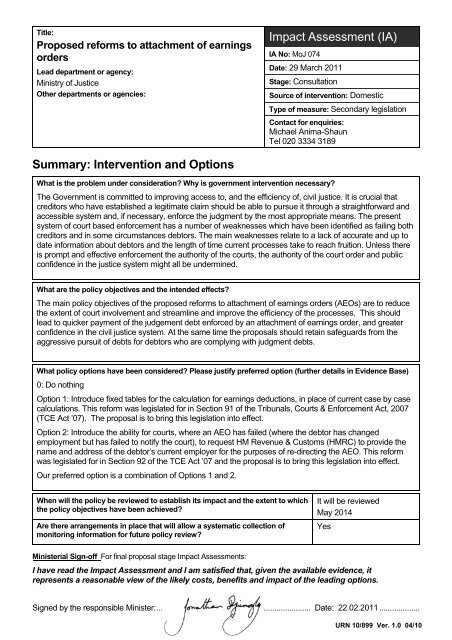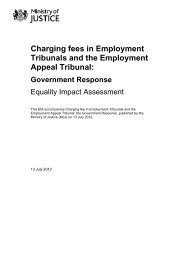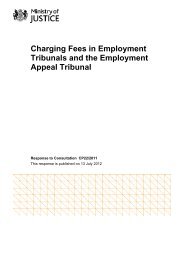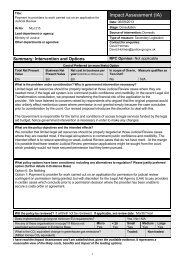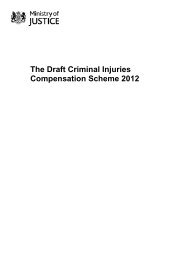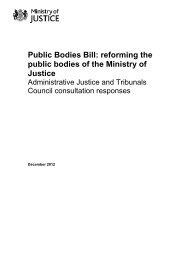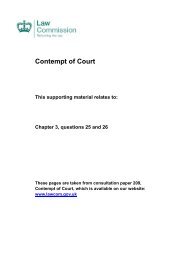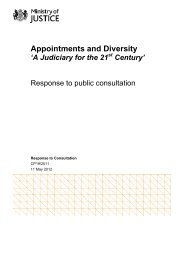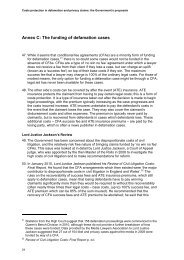Proposed reforms to attachment of earnings orders - Ministry of Justice
Proposed reforms to attachment of earnings orders - Ministry of Justice
Proposed reforms to attachment of earnings orders - Ministry of Justice
You also want an ePaper? Increase the reach of your titles
YUMPU automatically turns print PDFs into web optimized ePapers that Google loves.
Title:<br />
<strong>Proposed</strong> <strong>reforms</strong> <strong>to</strong> <strong>attachment</strong> <strong>of</strong> <strong>earnings</strong><br />
<strong>orders</strong><br />
Lead department or agency:<br />
<strong>Ministry</strong> <strong>of</strong> <strong>Justice</strong><br />
Other departments or agencies:<br />
Impact Assessment (IA)<br />
IA No: MoJ 074<br />
Date: 29 March 2011<br />
Stage: Consultation<br />
Source <strong>of</strong> intervention: Domestic<br />
Type <strong>of</strong> measure: Secondary legislation<br />
Contact for enquiries:<br />
Michael Anima-Shaun<br />
Tel 020 3334 3189<br />
Summary: Intervention and Options<br />
What is the problem under consideration Why is government intervention necessary<br />
The Government is committed <strong>to</strong> improving access <strong>to</strong>, and the efficiency <strong>of</strong>, civil justice. It is crucial that<br />
credi<strong>to</strong>rs who have established a legitimate claim should be able <strong>to</strong> pursue it through a straightforward and<br />
accessible system and, if necessary, enforce the judgment by the most appropriate means. The present<br />
system <strong>of</strong> court based enforcement has a number <strong>of</strong> weaknesses which have been identified as failing both<br />
credi<strong>to</strong>rs and in some circumstances deb<strong>to</strong>rs. The main weaknesses relate <strong>to</strong> a lack <strong>of</strong> accurate and up <strong>to</strong><br />
date information about deb<strong>to</strong>rs and the length <strong>of</strong> time current processes take <strong>to</strong> reach fruition. Unless there<br />
is prompt and effective enforcement the authority <strong>of</strong> the courts, the authority <strong>of</strong> the court order and public<br />
confidence in the justice system might all be undermined.<br />
What are the policy objectives and the intended effects<br />
The main policy objectives <strong>of</strong> the proposed <strong>reforms</strong> <strong>to</strong> <strong>attachment</strong> <strong>of</strong> <strong>earnings</strong> <strong>orders</strong> (AEOs) are <strong>to</strong> reduce<br />
the extent <strong>of</strong> court involvement and streamline and improve the efficiency <strong>of</strong> the processes. This should<br />
lead <strong>to</strong> quicker payment <strong>of</strong> the judgement debt enforced by an <strong>attachment</strong> <strong>of</strong> <strong>earnings</strong> order, and greater<br />
confidence in the civil justice system. At the same time the proposals should retain safeguards from the<br />
aggressive pursuit <strong>of</strong> debts for deb<strong>to</strong>rs who are complying with judgment debts.<br />
What policy options have been considered Please justify preferred option (further details in Evidence Base)<br />
0: Do nothing<br />
Option 1: Introduce fixed tables for the calculation for <strong>earnings</strong> deductions, in place <strong>of</strong> current case by case<br />
calculations. This reform was legislated for in Section 91 <strong>of</strong> the Tribunals, Courts & Enforcement Act, 2007<br />
(TCE Act ’07). The proposal is <strong>to</strong> bring this legislation in<strong>to</strong> effect.<br />
Option 2: Introduce the ability for courts, where an AEO has failed (where the deb<strong>to</strong>r has changed<br />
employment but has failed <strong>to</strong> notify the court), <strong>to</strong> request HM Revenue & Cus<strong>to</strong>ms (HMRC) <strong>to</strong> provide the<br />
name and address <strong>of</strong> the deb<strong>to</strong>r’s current employer for the purposes <strong>of</strong> re-directing the AEO. This reform<br />
was legislated for in Section 92 <strong>of</strong> the TCE Act ’07 and the proposal is <strong>to</strong> bring this legislation in<strong>to</strong> effect.<br />
Our preferred option is a combination <strong>of</strong> Options 1 and 2.<br />
When will the policy be reviewed <strong>to</strong> establish its impact and the extent <strong>to</strong> which<br />
the policy objectives have been achieved<br />
Are there arrangements in place that will allow a systematic collection <strong>of</strong><br />
moni<strong>to</strong>ring information for future policy review<br />
It will be reviewed<br />
May 2014<br />
Yes<br />
Ministerial Sign-<strong>of</strong>f For final proposal stage Impact Assessments:<br />
I have read the Impact Assessment and I am satisfied that, given the available evidence, it<br />
represents a reasonable view <strong>of</strong> the likely costs, benefits and impact <strong>of</strong> the leading options.<br />
Signed by the responsible Minister:........................................................................ Date: 22.02.2011 ...................<br />
1 URN 10/899 Ver. 1.0 04/10
Summary: Analysis and Evidence Policy Option 1<br />
Description: Fixed tables in calculating Earnings Deductions for <strong>attachment</strong> <strong>of</strong> <strong>earnings</strong> <strong>orders</strong><br />
Price Base<br />
Year<br />
PV Base<br />
Year<br />
Time Period<br />
Years<br />
Net Benefit (Present Value (PV)) (£m)<br />
Low: Optional High: Optional Best Estimate:<br />
COSTS (£m)<br />
Total Transition<br />
(Constant Price) Years<br />
Average Annual<br />
(excl. Transition) (Constant Price)<br />
Total Cost<br />
(Present Value)<br />
Low Optional Optional Optional<br />
High Optional Optional Optional<br />
Best Estimate<br />
Description and scale <strong>of</strong> key monetised costs by ‘main affected groups’<br />
Other key non-monetised costs by ‘main affected groups’<br />
One <strong>of</strong>f IT costs <strong>to</strong> HMCS and potentially <strong>to</strong> employers <strong>to</strong> install fixed table s<strong>of</strong>tware<br />
Additional familiarisation and awareness transitional costs <strong>to</strong> both HMCS and employers<br />
Costs <strong>to</strong> deb<strong>to</strong>rs from paying more quickly and more completely<br />
BENEFITS (£m)<br />
Total Transition<br />
(Constant Price) Years<br />
Average Annual<br />
(excl. Transition) (Constant Price)<br />
Total Benefit<br />
(Present Value)<br />
Low Optional Optional Optional<br />
High Optional Optional Optional<br />
Best Estimate<br />
Description and scale <strong>of</strong> key monetised benefits by ‘main affected groups’<br />
Other key non-monetised benefits by ‘main affected groups’<br />
Improved HMCS efficiency leading <strong>to</strong> reduced case backlog and reduced case waiting times<br />
Some credi<strong>to</strong>rs receive payment more quickly and potentially more completely<br />
Wider economic benefits from greater contractual certainty and enforceability<br />
Gains <strong>to</strong> equity and fairness<br />
Allows employers <strong>to</strong> use uniform system for deductions for criminal fines, civil debts and Council Tax. Costs<br />
reduced by utilising the same commercial s<strong>of</strong>tware products <strong>to</strong> implement the new system<br />
Key assumptions/sensitivities/risks Discount rate (%)<br />
Court fees and employer fees assumed <strong>to</strong> stay the same<br />
Ongoing cost implications unclear for employers<br />
Distributional implications unclear<br />
Bailiffs and legal pr<strong>of</strong>essionals assumed <strong>to</strong> adjust <strong>to</strong> changing pattern <strong>of</strong> business demand<br />
Volume <strong>of</strong> cases assumed <strong>to</strong> stay the same<br />
Overall potential impact on legal aid, if any, is assumed not <strong>to</strong> be significant<br />
Impact on admin burden (AB) (£m): Impact on policy cost savings (£m): In scope<br />
New AB: n/a AB savings: n/a Net: n/a Policy cost savings: n/a Yes/No<br />
2
Summary: Analysis and Evidence Policy Option 2<br />
Description: Finding the deb<strong>to</strong>r’s current employer<br />
Price Base<br />
Year<br />
PV Base<br />
Year<br />
Time Period<br />
Years<br />
Net Benefit (Present Value (PV)) (£m)<br />
Low: Optional High: Optional Best Estimate:<br />
COSTS (£m)<br />
Total Transition<br />
(Constant Price) Years<br />
Average Annual<br />
(excl. Transition) (Constant Price)<br />
Total Cost<br />
(Present Value)<br />
Low Optional Optional Optional<br />
High Optional Optional Optional<br />
Best Estimate<br />
Description and scale <strong>of</strong> key monetised costs by ‘main affected groups’<br />
One <strong>of</strong>f IT costs <strong>to</strong> HMRC <strong>of</strong> approximately £500,000 in set up costs.<br />
Ongoing annual running costs <strong>of</strong> around £50,000 per annum. Ultimately recovery <strong>of</strong> these ongoing costs<br />
would be achieved through fee income.<br />
The cost <strong>of</strong> setting up this link with HMRC also applies <strong>to</strong> information requests and <strong>orders</strong>, another policy<br />
we are consulting on. Therefore, the non-recoverable IT cost and any ongoing costs should not be double<br />
counted if both proposals are <strong>to</strong> be implemented.<br />
Other key non-monetised costs by ‘main affected groups’<br />
One <strong>of</strong>f IT costs <strong>to</strong> <strong>Ministry</strong> <strong>of</strong> <strong>Justice</strong> <strong>to</strong> change procedures<br />
Reduced court fee income from reduced <strong>orders</strong> <strong>to</strong> obtain information court caseload. However, we assume<br />
that this is matched by reduced costs, leaving the overall financial position neutral.<br />
Costs <strong>to</strong> deb<strong>to</strong>rs from paying more quickly and potentially more completely<br />
BENEFITS (£m)<br />
Total Transition<br />
(Constant Price) Years<br />
Average Annual<br />
(excl. Transition) (Constant Price)<br />
Total Benefit<br />
(Present Value)<br />
Low Optional Optional Optional<br />
High Optional Optional Optional<br />
Best Estimate<br />
Description and scale <strong>of</strong> key monetised benefits by ‘main affected groups’<br />
Other key non-monetised benefits by ‘main affected groups’<br />
Increased fee income from finding the deb<strong>to</strong>r’s current employer, set equal <strong>to</strong> the cost <strong>of</strong> this process,<br />
leaving the overall financial position neutral. .<br />
Some credi<strong>to</strong>rs receive payment more quickly and potentially more completely<br />
Some deb<strong>to</strong>rs gain from ultimately paying lower court fees<br />
Wider economic benefits from greater contractual certainty and enforceability from improved debt recovery<br />
Gains <strong>to</strong> equity and fairness<br />
Key assumptions/sensitivities/risks Discount rate (%)<br />
Distributional implications unclear<br />
Legal pr<strong>of</strong>essionals assumed <strong>to</strong> adjust <strong>to</strong> changing pattern <strong>of</strong> business demand<br />
Court fees assumed <strong>to</strong> stay the same for <strong>attachment</strong> <strong>of</strong> <strong>earnings</strong> <strong>orders</strong><br />
HMRC costs <strong>to</strong> provide information lower than HMCS costs they displace<br />
HMRC process quicker than HMCS process displaced<br />
Existing extent <strong>of</strong> non-compliance with Attachment <strong>of</strong> Earnings Orders remains the same<br />
Initial volume <strong>of</strong> Attachment <strong>of</strong> Earnings Orders cases remains the same.<br />
Uncertainty around the IT cost <strong>to</strong> set up the linkage with HMRC<br />
Overall potential impact on legal aid, if any, is assumed not <strong>to</strong> be significant<br />
Impact on admin burden (AB) (£m): Impact on policy cost savings (£m): In scope<br />
New AB: n/a AB savings: n/a Net: n/a Policy cost savings: n/a Yes/No<br />
3
Enforcement, Implementation and Wider Impacts<br />
What is the geographic coverage <strong>of</strong> the policy/option<br />
England and Wales<br />
From what date will the policy be implemented 01/05/2012<br />
Which organisation(s) will enforce the policy<br />
What is the annual change in enforcement cost (£m)<br />
Does enforcement comply with Hamp<strong>to</strong>n principles<br />
Does implementation go beyond minimum EU requirements<br />
What is the CO 2 equivalent change in greenhouse gas emissions<br />
(Million <strong>to</strong>nnes CO 2 equivalent)<br />
Does the proposal have an impact on competition<br />
What proportion (%) <strong>of</strong> Total PV costs/benefits is directly attributable <strong>to</strong><br />
primary legislation, if applicable<br />
HMCS (Civil Courts)<br />
Expect negligible<br />
Yes<br />
No<br />
Traded:<br />
n/a<br />
No<br />
Costs:<br />
n/a<br />
Non-traded:<br />
n/a<br />
Benefits:<br />
n/a<br />
Annual cost (£m) per organisation<br />
Micro < 20 Small Medium Large<br />
(excl. Transition) (Constant Price)<br />
Are any <strong>of</strong> these organisations exempt No No No No No<br />
Specific Impact Tests: Checklist<br />
Set out in the table below where information on any SITs undertaken as part <strong>of</strong> the analysis <strong>of</strong> the policy<br />
options can be found in the evidence base. For guidance on how <strong>to</strong> complete each test, double-click on<br />
the link for the guidance provided by the relevant department.<br />
Please note this checklist is not intended <strong>to</strong> list each and every statu<strong>to</strong>ry consideration that departments<br />
should take in<strong>to</strong> account when deciding which policy option <strong>to</strong> follow. It is the responsibility <strong>of</strong><br />
departments <strong>to</strong> make sure that their duties are complied with.<br />
Does your policy option/proposal have an impact on… Impact Page ref<br />
within IA<br />
Statu<strong>to</strong>ry equality duties 1<br />
Statu<strong>to</strong>ry Equality Duties Impact Test guidance<br />
Yes<br />
Economic impacts<br />
Competition Competition Assessment Impact Test guidance<br />
Small firms Small Firms Impact Test guidance<br />
Environmental impacts<br />
Greenhouse gas assessment Greenhouse Gas Assessment Impact Test guidance<br />
Wider environmental issues Wider Environmental Issues Impact Test guidance<br />
Social impacts<br />
Health and well-being Health and Well-being Impact Test guidance<br />
Human rights Human Rights Impact Test guidance<br />
<strong>Justice</strong> system <strong>Justice</strong> Impact Test guidance<br />
Rural pro<strong>of</strong>ing Rural Pro<strong>of</strong>ing Impact Test guidance<br />
Sustainable development<br />
Sustainable Development Impact Test guidance<br />
Yes<br />
Yes<br />
No<br />
No<br />
No<br />
No<br />
Yes<br />
No<br />
No<br />
1 Race, disability and gender Impact assessments are statu<strong>to</strong>ry requirements for relevant policies. Equality statu<strong>to</strong>ry requirements will be<br />
expanded 2011, once the Equality Bill comes in<strong>to</strong> force. Statu<strong>to</strong>ry equality duties part <strong>of</strong> the Equality Bill apply <strong>to</strong> GB only. The Toolkit provides<br />
advice on statu<strong>to</strong>ry equality duties for public authorities with a remit in Northern Ireland.<br />
4
Evidence Base (for summary sheets) – Notes<br />
Use this space <strong>to</strong> set out the relevant references, evidence, analysis and detailed narrative from which<br />
you have generated your policy options or proposal. Please fill in References section.<br />
References<br />
Include the links <strong>to</strong> relevant legislation and publications, such as public impact assessment <strong>of</strong> earlier<br />
stages (e.g. Consultation, Final, Enactment).<br />
No.<br />
Legislation or publication<br />
1 Tribunal, Courts and Enforcement Act 2007<br />
2 Effective Enforcement white paper (LCD) 2003<br />
3<br />
4<br />
+ Add another row<br />
Evidence Base<br />
Ensure that the information in this section provides clear evidence <strong>of</strong> the information provided in the<br />
summary pages <strong>of</strong> this form (recommended maximum <strong>of</strong> 30 pages). Complete the Annual pr<strong>of</strong>ile <strong>of</strong><br />
monetised costs and benefits (transition and recurring) below over the life <strong>of</strong> the preferred policy (use<br />
the spreadsheet attached if the period is longer than 10 years).<br />
The spreadsheet also contains an emission changes table that you will need <strong>to</strong> fill in if your measure has<br />
an impact on greenhouse gas emissions.<br />
Annual pr<strong>of</strong>ile <strong>of</strong> monetised costs and benefits* - (£m) constant prices<br />
Transition costs<br />
Annual recurring cost<br />
Total annual costs<br />
Transition benefits<br />
Annual recurring benefits<br />
Total annual benefits<br />
Y 0 Y 1 Y 2 Y 3 Y 4 Y 5 Y 6 Y 7 Y 8 Y 9<br />
* For non-monetised benefits please see summary pages and main evidence base section<br />
5
Evidence Base (for summary sheets)<br />
1. Introduction<br />
Background<br />
1.1 The Government believes that responsible credi<strong>to</strong>rs who are owed money and have gained<br />
judgment in a court should have the right <strong>to</strong> enforce that judgment. Equally, deb<strong>to</strong>rs should be<br />
protected from the oppressive pursuit <strong>of</strong> their debts.<br />
1.2 Effective enforcement is crucial <strong>to</strong> both the criminal and civil justice systems. People ordered <strong>to</strong><br />
pay a court judgment, criminal penalties and compensation awards, or <strong>to</strong> comply with the terms<br />
<strong>of</strong> a community sentence, have little or no incentive <strong>to</strong> do so if they know there is no effective<br />
means <strong>of</strong> enforcing it. Unless there is prompt and efficient enforcement, the authority <strong>of</strong> the<br />
courts, the deterrent value <strong>of</strong> penalties and public confidence in the justice systems might all be<br />
undermined.<br />
1.3 Under the existing arrangements, following a judgment after a payment has not been received a<br />
credi<strong>to</strong>r may apply <strong>to</strong> the court <strong>to</strong> enforce the judgment. The credi<strong>to</strong>r will decide which <strong>of</strong> the<br />
following court based enforcement methods they favour such as: <strong>attachment</strong> <strong>of</strong> <strong>earnings</strong> order<br />
(AEO), charging <strong>orders</strong>, third party debt <strong>orders</strong>, judgment summonses, or warrants <strong>of</strong> execution.<br />
1.4 This impact assessment focuses on <strong>attachment</strong> <strong>of</strong> <strong>earnings</strong> <strong>orders</strong> only. The <strong>reforms</strong> apply <strong>to</strong> all<br />
forms <strong>of</strong> civil case but not <strong>to</strong> family or criminal cases. They relate <strong>to</strong> all civil cases where an<br />
<strong>attachment</strong> <strong>of</strong> <strong>earnings</strong> order has been obtained in order <strong>to</strong> secure money from the deb<strong>to</strong>r. This<br />
might be all forms <strong>of</strong> civil case where payments are owed, not just cases involving money<br />
lending.<br />
1.5 In 2009 there were approximately 61,000 <strong>attachment</strong> <strong>of</strong> <strong>earnings</strong> <strong>orders</strong> issued in the County<br />
Court. Our proposed changes (already legislated for in the TCE Act ’07) aim <strong>to</strong> improve the<br />
effectiveness <strong>of</strong> these as an enforcement method, whilst still <strong>of</strong>fering protection <strong>to</strong> deb<strong>to</strong>rs who<br />
are genuinely unable <strong>to</strong> pay.<br />
Policy Objectives<br />
1.6 Efficiency and fairness concerns are driving our proposed <strong>reforms</strong>. If the Government does<br />
nothing then the current process for <strong>attachment</strong> <strong>of</strong> <strong>earnings</strong> would continue <strong>to</strong> apply. However<br />
this would not address the present failings - repayment through <strong>attachment</strong> <strong>of</strong> <strong>earnings</strong> would<br />
continue <strong>to</strong> be potentially sporadic and easy <strong>to</strong> evade, and confidence in the justice system might<br />
not improve. We cannot say whether or not the problem would worsen, since this would require<br />
predicting future behavioural changes between the disparate groups involved in court processes.<br />
We have assumed, however, that the problems are unlikely <strong>to</strong> rectify themselves, since this<br />
would probably already have happened over the course <strong>of</strong> time.<br />
Policy Proposals<br />
1.7 We propose implementing the Part 4 <strong>of</strong> the TCE Act ’07 in relation <strong>to</strong> <strong>attachment</strong> <strong>of</strong> <strong>earnings</strong>.<br />
1.8 This would include:<br />
1) Introducing fixed tables for the calculation for <strong>earnings</strong> deductions, in place <strong>of</strong> current case by<br />
case calculations.<br />
2) Introducing the ability for courts, where an AEO has failed (where the deb<strong>to</strong>r has changed<br />
employment but has failed <strong>to</strong> notify the court), <strong>to</strong> request HM Revenue & Cus<strong>to</strong>ms (HMRC) <strong>to</strong><br />
provide the name and address <strong>of</strong> the deb<strong>to</strong>r’s current employer for the purposes <strong>of</strong> redirecting<br />
the AEO<br />
1.9 By implementing these policies, already legislated for in the TCE Act ‘07, the Government<br />
believes that it can provide a simpler, consistent and more effective process <strong>of</strong> enforcement by:<br />
6
Improving the ability <strong>of</strong> responsible credi<strong>to</strong>rs <strong>to</strong> recoup monies owed <strong>to</strong> them more quickly.<br />
Assisting credi<strong>to</strong>rs in tracking down deb<strong>to</strong>r’s employment if they change employers.<br />
Providing increased certainty and consistency in the implementation <strong>of</strong> enforcement <strong>orders</strong>.<br />
Protecting deb<strong>to</strong>rs who are unable <strong>to</strong> repay debt at the fixed rates set.<br />
Economic rationale for intervention<br />
1.10 The conventional economic approach <strong>to</strong> government intervention <strong>to</strong> resolve a problem is based<br />
on efficiency or equity arguments. The Government may consider intervening if there are strong<br />
enough failures in the way markets operate (e.g. monopolies overcharging consumers) or if there<br />
are strong enough failures in existing government interventions (e.g. waste generated by<br />
misdirected rules). In both cases the proposed new intervention itself should avoid creating a<br />
further set <strong>of</strong> disproportionate costs and dis<strong>to</strong>rtions. The Government may also intervene for<br />
equity (fairness) and redistributional reasons (e.g. <strong>to</strong> reallocate goods and services <strong>to</strong> the more<br />
needy groups in society).<br />
1.11 In this case, the intervention would be justified on both efficiency and fairness grounds. From an<br />
efficiency perspective, fewer resources might be required <strong>to</strong> calculate deductions and <strong>to</strong> obtain<br />
information about the deb<strong>to</strong>r’s new employer. In relation <strong>to</strong> the latter, a significant reduction in<br />
the time and resources required <strong>to</strong> pursue enforcement action may at the margin lead <strong>to</strong> more<br />
cases being fully enforced, with wider economic benefits for the operation <strong>of</strong> markets and for<br />
contractual certainty.<br />
1.12 Improved enforcement <strong>of</strong> contracts and <strong>of</strong> judgments should lead <strong>to</strong> an improvement <strong>of</strong> fairness,<br />
especially as the initial judgment order hearing would have considered if the contract itself was<br />
fair and should be enforced, and would have applied a reasonable repayment pr<strong>of</strong>ile given the<br />
deb<strong>to</strong>r’s financial position.<br />
1.13 Greater consistency in the calculation <strong>of</strong> deductions might also be fairer, assuming that the<br />
deductions tables still provide sufficient flexibility. Rates in tables may be varied over time simply<br />
by adjusting the s<strong>of</strong>tware. The tables also carry a protected minimal percentage under which<br />
deductions will not be made.<br />
Affected key stakeholder groups<br />
1.14 The proposals will affect the civil courts, credi<strong>to</strong>rs, deb<strong>to</strong>rs, and third parties - employers, HMRC<br />
and bailiff services.<br />
• Civil Courts – Will be impacted in terms <strong>of</strong> workload in obtaining information about deb<strong>to</strong>rs and<br />
in calculating deductions. Costs will arise in relation <strong>to</strong> linkages with third parties (HMRC).<br />
• Credi<strong>to</strong>rs – Will be impacted in terms <strong>of</strong> the speed and potential likelihood <strong>of</strong> debt repayment.<br />
• Deb<strong>to</strong>rs – Will be affected in terms <strong>of</strong> the speed <strong>of</strong> debt repayment, potential engagement with<br />
the courts, and the likelihood <strong>of</strong> debt repayment.<br />
• Employers – May see an additional burden through the requirement <strong>to</strong> install (and operate)<br />
fixed tables s<strong>of</strong>tware. As many employers may already own this s<strong>of</strong>tware for other deductions<br />
(e.g. criminal fines and Council Tax) some may see a reduced burden in not having <strong>to</strong> run two<br />
completely different systems as they do now.<br />
• HMRC – Will be required <strong>to</strong> coordinate with HM Courts Service (HMCS) in terms <strong>of</strong> requests for<br />
information about deb<strong>to</strong>rs’ employers.<br />
• Court Bailiffs – May see a reduced workload if they no longer need <strong>to</strong> undertake service <strong>of</strong><br />
Attachment <strong>of</strong> Earnings related court process documents on deb<strong>to</strong>rs.<br />
• Legal pr<strong>of</strong>essionals – Might possibly be affected by the possible improved efficiency and<br />
effectiveness <strong>of</strong> enforcement <strong>orders</strong> and their implementation.<br />
• Legal Services Commission (LSC) – The LSC administers legal aid and might possibly be<br />
affected if there is a change in demand for legal advice funded by legal aid, which could include<br />
advice provided by the not for pr<strong>of</strong>it sec<strong>to</strong>r. It is unclear whether these impacts would arise and<br />
7
if so, how significant they might be. Given this we have assumed that the overall impact on<br />
legal aid, if any, is unlikely <strong>to</strong> be significant.<br />
2. Costs & Benefits<br />
2. 1 This Impact Assessment identifies both monetised and non-monetised impacts on individuals,<br />
groups and businesses in the UK, with the aim <strong>of</strong> understanding what the overall impact <strong>to</strong><br />
society might be from implementing the options considered. The costs and benefits <strong>of</strong> each<br />
option are compared <strong>to</strong> the do nothing option. Impact Assessments place a strong emphasis on<br />
valuing the costs and benefits in monetary terms (including estimating the value <strong>of</strong> goods and<br />
services that are not traded). However there are important aspects that cannot sensibly be<br />
monetised which might include how the proposals impact differently on particular groups <strong>of</strong><br />
society or changes in equity and fairness.<br />
2. 2 This impact assessment considers the impacts on the above groups under the different options<br />
for enforcing aspects <strong>of</strong> the TCE Act ’07 in relation <strong>to</strong> <strong>attachment</strong> <strong>of</strong> <strong>earnings</strong> <strong>orders</strong>.<br />
Option 0: Base case (do nothing)<br />
2. 3 Under this option, no intervention would be made. Therefore, methods <strong>to</strong> obtain information<br />
about deb<strong>to</strong>rs and the calculation for <strong>earnings</strong> deductions would be undertaken in the same way<br />
as now, relying on court staff <strong>to</strong> individually calculate each AEO order depending on the<br />
information provided by the deb<strong>to</strong>r. In particular, information about a deb<strong>to</strong>r’s employer when an<br />
AEO fails (as the deb<strong>to</strong>r has changed employer) can only be obtained through requesting this<br />
from the deb<strong>to</strong>r (and not from HMRC). This may involve repeated involvement <strong>of</strong> the court and<br />
the use <strong>of</strong> bailiffs, resulting in unnecessary delay and which remains subject <strong>to</strong> the deb<strong>to</strong>r’s<br />
engagement. The base case would also allow current arrangements <strong>to</strong> continue whereby<br />
employers are obliged <strong>to</strong> use two different procedures for deducting from <strong>earnings</strong>.<br />
2. 4 All options are assessed relative <strong>to</strong> the base case. As such, the costs or benefits associated with<br />
the base case are necessarily zero.<br />
Option 1: Introduce fixed tables calculations for <strong>earnings</strong> deductions in <strong>attachment</strong> <strong>of</strong><br />
<strong>earnings</strong> <strong>orders</strong> (TCE Act ’07 – Section 91)<br />
Description<br />
2. 5 Under the current system for judgment debts in the County Court, the court relies on the deb<strong>to</strong>r's<br />
completion <strong>of</strong> a means form (N56) <strong>to</strong> calculate a Protected Earnings Rate (PER) and a Normal<br />
Deduction Rate (NDR). This <strong>of</strong>ten leads <strong>to</strong> unnecessary delay. Some deb<strong>to</strong>rs do not return the<br />
means form when asked <strong>to</strong> do so. If it is not returned after 14 days, a County Court bailiff must<br />
serve the documents personally on the deb<strong>to</strong>r and this may require several visits <strong>to</strong> the deb<strong>to</strong>r's<br />
address before documents can be served. There can also be issues surrounding the reliability <strong>of</strong><br />
the information supplied by deb<strong>to</strong>rs.<br />
2. 6 Introducing fixed tables setting out deductions at fixed rates for AEOs made by the County Court<br />
<strong>to</strong> secure a judgment debt would remove the need for a means form <strong>to</strong> be completed. Once the<br />
court has made an order the employer would be instructed <strong>to</strong> apply the deduction rate specified<br />
as a percentage <strong>of</strong> the <strong>to</strong>tal applicable <strong>earnings</strong> in the tables. The deb<strong>to</strong>r would still have 14 days<br />
<strong>to</strong> respond once the order has been made, but after that time the deductions would begin<br />
au<strong>to</strong>matically. The aim is <strong>to</strong> make the process more straightforward at the court end, and<br />
therefore <strong>to</strong> speed up the process.<br />
2. 7 With fixed deductions tables employers would also have a system that provides more certainty<br />
and is more consistent with other the deduction schemes they operate in relation <strong>to</strong> Council Tax<br />
and unpaid fines.<br />
2. 8 Fixed tables would specify, given the deb<strong>to</strong>r’s net pay over a certain pay period, the percentage<br />
<strong>of</strong> their salary that would be deducted each period <strong>to</strong> pay for the debt. There would be a lower<br />
limit (<strong>to</strong> be determined in secondary legislation) meaning that those who earn below a certain<br />
8
amount per pay period would be subject <strong>to</strong> a 0% rate. This is very similar <strong>to</strong> how deductions<br />
under Council Tax AEOs work.<br />
2. 9 We would look at setting the County Court fixed tables at a lower level than the Council Tax<br />
tables because although the judgment debt is important;<br />
a. Council Tax has traditionally had a higher priority in terms <strong>of</strong> collection because it is a tax;<br />
and<br />
b. Council Tax debt arrears are based on debts accrued in one tax year and therefore<br />
repayment has <strong>to</strong> be made over a short period, 12-18 months, <strong>to</strong> ensure arrears for the<br />
following year are not built up.<br />
2. 10 The exact levels will only be set after careful consideration with key stakeholders.<br />
2. 11 There would continue <strong>to</strong> be provision for any party <strong>to</strong> request a review <strong>of</strong> the fixed table<br />
deductions, meaning those who genuinely cannot pay would continue <strong>to</strong> be protected.<br />
Costs <strong>of</strong> Option 1<br />
HMCS (Civil Courts)<br />
2. 12 Potential one-<strong>of</strong>f costs <strong>to</strong> HMCS <strong>to</strong> update IT systems and leaflets. These costs should be<br />
quantified in due course.<br />
2. 13 It is possible that the <strong>reforms</strong> may lead <strong>to</strong> a reduced HMCS workload. Whilst case volumes are<br />
assumed <strong>to</strong> remain the same there should be less HMCS work involved in each case. If this<br />
enabled HMCS court capacity <strong>to</strong> be reduced then there might be associated one-<strong>of</strong>f capacity<br />
adjustment costs, e.g. from terminating contracts. It has been assumed that these <strong>reforms</strong> by<br />
themselves are unlikely <strong>to</strong> result in any court capacity adjustment, and hence that court capacity<br />
adjustment costs would not be incurred.<br />
2. 14 Where the deb<strong>to</strong>r requests that the application <strong>of</strong> the fixed tables is reviewed it has been<br />
assumed that the costs <strong>to</strong> HMCS <strong>of</strong> administering such cases should be the same as the costs <strong>of</strong><br />
administering them under existing processes. Hence additional costs should not arise from the<br />
review provision.<br />
2. 15 Court fees are assumed not <strong>to</strong> change as a result <strong>of</strong> these proposals, nor are court case<br />
volumes. HMCS should not, therefore, experience a reduction in <strong>to</strong>tal fee income.<br />
Deb<strong>to</strong>rs<br />
2. 16 A more efficient process for calculating salary deductions should allow HMCS <strong>to</strong> action the<br />
<strong>attachment</strong> <strong>of</strong> <strong>earnings</strong> order more rapidly. This should lead <strong>to</strong> deb<strong>to</strong>rs beginning <strong>to</strong> repay their<br />
judgment debt more quickly and, in some cases, <strong>to</strong> debts being repaid more completely. Overall<br />
there may be an increase in the <strong>to</strong>tal amount paid by deb<strong>to</strong>rs <strong>to</strong> credi<strong>to</strong>rs. Payments may also be<br />
made more quickly as a result <strong>of</strong> HMCS cost savings translating in<strong>to</strong> a reduction in the case<br />
backlog and in case waiting times.<br />
Credi<strong>to</strong>rs<br />
2. 17 No significant one-<strong>of</strong>f or ongoing costs <strong>to</strong> credi<strong>to</strong>rs have been identified.<br />
Employers<br />
2. 18 The <strong>reforms</strong> would shift the onus <strong>of</strong> calculating <strong>earnings</strong> deductions from HMCS <strong>to</strong> employers.<br />
There may be one-<strong>of</strong>f costs <strong>to</strong> businesses if they do not currently have fixed table s<strong>of</strong>tware<br />
installed, and if they are required <strong>to</strong> obtain this s<strong>of</strong>tware in order <strong>to</strong> complete the <strong>attachment</strong> <strong>of</strong><br />
<strong>earnings</strong> order. There may also be associated staff training costs. Whether additional one-<strong>of</strong>f<br />
costs are likely <strong>to</strong> arise would depend on whether firms already hold the necessary s<strong>of</strong>tware for<br />
Council Tax or other purposes. It is possible that many firms may already have this s<strong>of</strong>tware<br />
given that it is widely used for other purposes.<br />
9
2. 19 There would also be ongoing costs from applying the s<strong>of</strong>tware. It is unclear whether these<br />
ongoing costs would be greater than the costs <strong>to</strong> employers <strong>of</strong> operating the current system.<br />
This might be possible in some cases. It has been assumed that employers would not be able <strong>to</strong><br />
charge for any increased costs which they might incur, i.e. that the fixed charge currently levied<br />
by employers per transaction would remain the same.<br />
Bailiffs<br />
2. 20 Bailiffs are likely <strong>to</strong> experience a reduction in business from the enforcement <strong>of</strong> AEOs. (This loss<br />
<strong>to</strong> bailiffs would be mirrored by the gain <strong>to</strong> deb<strong>to</strong>rs from no longer paying the related bailiff fees).<br />
2. 21 It is possible that bailiffs may engage in other enforcement activity relating <strong>to</strong> other types <strong>of</strong> case,<br />
or may engage in other lines <strong>of</strong> work. Bailiffs may incur one-<strong>of</strong>f costs as a result <strong>of</strong> adjusting <strong>to</strong><br />
any changing pattern <strong>of</strong> demand. Whether bailiffs are worse <strong>of</strong>f as a result <strong>of</strong> these proposals<br />
would depend upon how their work pr<strong>of</strong>ile changes. It has been assumed in this Impact<br />
Assessment that bailiffs will pursue other work <strong>of</strong> an equivalent value and would not experience<br />
any increased ongoing costs.<br />
Legal pr<strong>of</strong>essionals<br />
2. 22 The position for legal pr<strong>of</strong>essions is similar <strong>to</strong> that for bailiffs. It is possible that legal<br />
pr<strong>of</strong>essionals may experience a reduction in business from the enforcement <strong>of</strong> AEOs as a result<br />
<strong>of</strong> more effective and streamlined processes. This may be associated with reduced fee income<br />
from AEO enforcement activity.<br />
2. 23 This loss <strong>to</strong> legal pr<strong>of</strong>essionals would be mirrored by the gain <strong>to</strong> deb<strong>to</strong>rs from no longer paying<br />
the related fees (and <strong>to</strong> credi<strong>to</strong>rs in relation <strong>to</strong> fees which cannot be recovered from the deb<strong>to</strong>r).<br />
2. 24 As with bailiffs it is possible that legal pr<strong>of</strong>essionals may engage in other activity relating <strong>to</strong> other<br />
types <strong>of</strong> case, or may engage in other lines <strong>of</strong> work. Legal pr<strong>of</strong>essionals may incur one-<strong>of</strong>f costs<br />
as a result <strong>of</strong> adjusting <strong>to</strong> any changing pattern <strong>of</strong> demand. Whether legal pr<strong>of</strong>essionals are<br />
worse <strong>of</strong>f as a result <strong>of</strong> these proposals would depend upon how their work pr<strong>of</strong>ile changes. It<br />
has been assumed in this Impact Assessment that legal pr<strong>of</strong>essionals will pursue other work <strong>of</strong><br />
an equivalent value and would not experience any ongoing costs.<br />
Distributional costs<br />
2. 25 The application <strong>of</strong> fixed tables in place <strong>of</strong> case by case calculations may lead <strong>to</strong> some deb<strong>to</strong>rs<br />
paying more quickly than would previously have been the case, and <strong>to</strong> others paying more<br />
slowly. The overall distributional impact amongst deb<strong>to</strong>rs is unknown.<br />
2. 26 At an aggregate level, deb<strong>to</strong>rs as a whole are likely <strong>to</strong> pay credi<strong>to</strong>rs more quickly, and may also<br />
repay debts more completely. Whether the distributional consequences <strong>of</strong> this transfer are<br />
considered <strong>to</strong> be positive or adverse would depend upon the nature <strong>of</strong> each party. For example<br />
in relation <strong>to</strong> borrowing, the credi<strong>to</strong>rs might be financial institutions and the deb<strong>to</strong>rs might be less<br />
well <strong>of</strong>f individuals.<br />
Equity and fairness costs<br />
2. 27 The proposals are not expected <strong>to</strong> reduce equity or fairness, especially as it will be possible <strong>to</strong><br />
request a review <strong>of</strong> the fixed table calculations. Cases which are subject <strong>to</strong> such reviews are<br />
assumed <strong>to</strong> be subject <strong>to</strong> the same degree <strong>of</strong> fairness as current cases.<br />
2. 28 The original enforcement hearing would have considered whether the contract which has not<br />
been honoured was fair. Implementing more effectively a judgement ruling which itself is<br />
considered <strong>to</strong> be fair should not lead <strong>to</strong> reduced fairness.<br />
Wider social and economic costs<br />
2. 29 The proposals are not expected <strong>to</strong> generate wider social and economic costs. Such wider costs<br />
might in theory arise as a result <strong>of</strong> deb<strong>to</strong>r-related behavioural responses (e.g. increased crime) or<br />
as a result <strong>of</strong> improved enforcement generating costs elsewhere (e.g. increased state benefits<br />
paid <strong>to</strong> deb<strong>to</strong>rs from government bodies).<br />
10
Benefits <strong>of</strong> Option 1<br />
HMCS (Civil Courts)<br />
2. 30 Ongoing savings <strong>to</strong> staff time through avoiding the requirement <strong>to</strong> process a means form from<br />
deb<strong>to</strong>rs, which is administered by the court. HMCS staff would also no longer need <strong>to</strong> calculate<br />
protected <strong>earnings</strong> rates or deductions, and this is likely <strong>to</strong> represent a more significant time<br />
saving.<br />
2. 31 As explained in the costs section it has been assumed that these <strong>reforms</strong> alone are unlikely <strong>to</strong><br />
enable court capacity <strong>to</strong> be reduced and hence <strong>to</strong> generate any related savings e.g. from having<br />
fewer staff or buildings. Instead there may be a reduction in ongoing variable court costs per<br />
case.<br />
2. 32 Total court costs might not necessarily fall. Instead it has been assumed that the reduction in per<br />
case costs would lead <strong>to</strong> a reduction in the County Court backlog and in associated waiting<br />
times. As such there may be no impact on overall court cost recovery.<br />
Deb<strong>to</strong>rs<br />
2. 33 For deb<strong>to</strong>rs, there may be a time saving through no longer having <strong>to</strong> engage with the court<br />
through completing a N56 statement <strong>of</strong> means form.<br />
2. 34 Deb<strong>to</strong>rs would also benefit from the reduced involvement <strong>of</strong> bailiffs, whose fees ultimately are<br />
paid by deb<strong>to</strong>rs. The same applies in relation <strong>to</strong> any reduced legal pr<strong>of</strong>essional fees which might<br />
be incurred by deb<strong>to</strong>rs.<br />
Credi<strong>to</strong>rs<br />
2. 35 Credi<strong>to</strong>rs would benefit as the process for commencing an <strong>attachment</strong> <strong>of</strong> <strong>earnings</strong> order would<br />
take place more quickly. This would ultimately result in the judgment debt being repaid more<br />
quickly. In addition there may be an increase in the number <strong>of</strong> complete repayments, i.e. in the<br />
<strong>to</strong>tal volume <strong>of</strong> repayments, depending on how monthly deductions would compare <strong>to</strong> their<br />
current levels.<br />
2. 36 Credi<strong>to</strong>rs may also gain if their (unrecoverable) legal pr<strong>of</strong>essional fees are lower under the new<br />
arrangements. Although their legal fees should ultimately be passed on <strong>to</strong> the deb<strong>to</strong>r, not all <strong>of</strong><br />
their fees might be recoverable in this way.<br />
Employers<br />
2. 37 It is unclear whether the ongoing costs <strong>of</strong> operating the new system are lower than that <strong>of</strong> the<br />
current system. This may be the case for some employers who already operate fixed table<br />
systems for other types <strong>of</strong> debt repayment. It has been assumed that the fixed charge currently<br />
levied by employers per transaction would remain the same.<br />
Bailiffs<br />
2. 38 No benefits are anticipated for bailiffs.<br />
Legal pr<strong>of</strong>essionals<br />
2. 39 No benefits are anticipated for legal pr<strong>of</strong>essionals.<br />
Distributional benefits<br />
2. 40 The application <strong>of</strong> fixed tables in place <strong>of</strong> case by case calculations may lead <strong>to</strong> some deb<strong>to</strong>rs<br />
paying more quickly than would previously have been the case, and <strong>to</strong> others paying more<br />
slowly. The overall distributional impact amongst deb<strong>to</strong>rs is unknown.<br />
2. 41 At an aggregate level, deb<strong>to</strong>rs as a whole are likely <strong>to</strong> pay credi<strong>to</strong>rs more quickly, and may also<br />
repay debts more completely. Whether the distributional consequences <strong>of</strong> this transfer are<br />
considered <strong>to</strong> be positive or adverse would depend upon the nature <strong>of</strong> each party. For example<br />
11
in relation <strong>to</strong> unpaid business, the credi<strong>to</strong>r might be a small firm and the deb<strong>to</strong>r might be a<br />
wealthy individual.<br />
Equity and fairness benefits<br />
2. 42 The proposals are expected <strong>to</strong> raise equity and fairness, as the original judgment is assumed <strong>to</strong><br />
be fair hence the quicker, more effective and more complete implementation <strong>of</strong> this judgment<br />
should improve fairness.<br />
Wider social and economic benefits<br />
2. 43 The proposals may generate wider social and economic benefits associated with the improved<br />
functioning <strong>of</strong> markets stemming from greater contractual certainty and enforceability.<br />
Option 1: Summary <strong>of</strong> key assumptions<br />
2. 44 The following key assumptions apply <strong>to</strong> Option 1:<br />
- The volume <strong>of</strong> cases is assumed <strong>to</strong> remain the same. Given the benefits <strong>to</strong> credi<strong>to</strong>rs,<br />
however, it is possible that case volumes might rise.<br />
- Court fees are assumed <strong>to</strong> remain the same. The reduction in court costs per case is<br />
assumed <strong>to</strong> lead <strong>to</strong> a reduction in the case backlog and hence in case waiting times. As a<br />
result overall court cost recovery would not be affected.<br />
- Court capacity (including staff and estate) is assumed not <strong>to</strong> be affected by these<br />
proposals.<br />
- Employer fees are assumed <strong>to</strong> remain the same per transaction.<br />
- Bailiffs and legal pr<strong>of</strong>essions are assumed <strong>to</strong> incur one-<strong>of</strong>f adjustment costs from their<br />
changing pattern <strong>of</strong> demand but are assumed <strong>to</strong> incur no change in ongoing costs or<br />
income once they have adjusted <strong>to</strong> undertaking less AEO business and more other<br />
business.<br />
- Where a deb<strong>to</strong>r requests a review <strong>of</strong> the fixed table deductions these cases are assumed <strong>to</strong><br />
exhibit the same characteristics as cases under existing arrangements. In effect the<br />
volume <strong>of</strong> cases subject <strong>to</strong> the new arrangements reduces by the volume <strong>of</strong> cases subject<br />
<strong>to</strong> a review.<br />
- We have assumed that the overall impact on legal aid, if any, is unlikely <strong>to</strong> be significant<br />
Option 2: To introduce a means <strong>of</strong> finding the deb<strong>to</strong>r’s employer in <strong>attachment</strong> <strong>of</strong><br />
<strong>earnings</strong> cases (TCE Act ’07 – Section 92)<br />
Description<br />
2. 45 Under the current system, employment details can only be obtained from the deb<strong>to</strong>r. There are<br />
no powers <strong>to</strong> obtain this information from other parties who may hold it.<br />
2. 46 If a deb<strong>to</strong>r changes employment and fails <strong>to</strong> notify the court <strong>of</strong> the new employer’s details the<br />
AEO fails, and recovery <strong>of</strong> the debt ceases. The credi<strong>to</strong>r is therefore required provide the court<br />
with information <strong>of</strong> the deb<strong>to</strong>r’s new employer if the AEO is <strong>to</strong> continue. It may be that a new<br />
order <strong>to</strong> obtain information is required <strong>to</strong> do this. If the Government does not amend the AEO<br />
process, credi<strong>to</strong>rs would continue <strong>to</strong> suffer undue delay with recovery <strong>of</strong> judgment debts by AEO.<br />
2. 47 The opening <strong>of</strong> an information gateway between the relevant court and HMRC should enable<br />
failed AEOs <strong>to</strong> be redirected <strong>to</strong> the current employer. The policy should ensure fewer AEOs<br />
would fail due <strong>to</strong> the deb<strong>to</strong>r failing in their responsibilities.<br />
2. 48 HMRC would only be approached if the deb<strong>to</strong>r has failed <strong>to</strong> provide the court with new<br />
employment details when, and if, they change employment whilst an order is in place. Provisions<br />
in the TCE Act 2007 allow information gateways <strong>to</strong> be opened for all types <strong>of</strong> AEOs covered by<br />
12
the 1971 Attachment <strong>of</strong> Earnings Act, and for AEOs made in relation <strong>to</strong> fine collection under<br />
Schedule 5 <strong>to</strong> the Courts Act 2003. We do not know how many AOEs fail per year.<br />
2. 49 These provisions would relate <strong>to</strong> civil and family matters only, not <strong>to</strong> criminal cases.<br />
2. 50 The policy would aim <strong>to</strong> achieve the following:<br />
• Reduce the delay in implementing <strong>attachment</strong> <strong>of</strong> <strong>earnings</strong> cases when a deb<strong>to</strong>r has changed<br />
employer.<br />
• Increase the difficulty for the deb<strong>to</strong>r <strong>to</strong> avoid or delay debt repayment.<br />
• Prevent the need for credi<strong>to</strong>rs <strong>to</strong> apply <strong>to</strong> the court more than once in relation <strong>to</strong> securing and<br />
implementing an <strong>attachment</strong> <strong>of</strong> <strong>earnings</strong> order.<br />
Costs <strong>of</strong> Option 2<br />
HMCS (Civil Courts)<br />
2. 51 There would be a one-<strong>of</strong>f cost <strong>of</strong> setting up an IT linkage with HMRC, estimated at approximately<br />
£500,000. The IT change would not involve major procurement and could be implemented via a<br />
central site <strong>to</strong> ensure implementation costs are as low as possible. There may also be potential<br />
HMCS IT adjustment costs, <strong>to</strong> adjust their systems for this new process, as well as small one-<strong>of</strong>f<br />
costs associated with providing information about this new means <strong>to</strong> find a deb<strong>to</strong>r’s employer.<br />
2. 52 There would be ongoing costs <strong>of</strong> operating this linkage with HMRC, <strong>to</strong> cover their additional<br />
administrative costs. These ongoing costs are estimated at around £50,000 per annum.<br />
However, as assume the costs <strong>of</strong> operating this linkage would be covered through additional fees<br />
charged for this service, hence ongoing net costs <strong>to</strong> HMCS should be zero.<br />
2. 53 There could be an ongoing loss <strong>of</strong> court fee income as deb<strong>to</strong>rs may not go back <strong>to</strong> the court <strong>to</strong><br />
secure an order <strong>to</strong> obtain information about the deb<strong>to</strong>r’s new employer. As in the case <strong>of</strong> fixed<br />
tables, this loss <strong>of</strong> court fee income would mirror a reduction in HMCS costs, so net costs <strong>to</strong><br />
HMCS should be zero. Therefore, overall the proposals are considered <strong>to</strong> have no overall impact<br />
on HMCS cost recovery.<br />
2. 54 As for Option 1, it has been assumed that the <strong>reforms</strong> would not lead <strong>to</strong> any HMCS capacity<br />
adjustment in relation <strong>to</strong> staff and estate and hence there would not be any one-<strong>of</strong>f capacity<br />
adjustment costs e.g. from terminating contracts.<br />
2. 55 There may be a potential increase in workload for defending court clerks against the <strong>of</strong>fence <strong>of</strong><br />
wrongful disclosure <strong>of</strong> information obtained from HMRC. Good regulations and guidance will<br />
assist here, mitigating this potential impact.<br />
Deb<strong>to</strong>rs<br />
2. 56 If deb<strong>to</strong>rs change employers, it will now be more difficult for them <strong>to</strong> evade the process, or stall<br />
the process. Therefore, for those deb<strong>to</strong>rs who change employers currently and do not report this,<br />
there would be a loss associated with the AEO being transferred <strong>to</strong> their new employer. In effect,<br />
assuming some non-compliance with requirements <strong>to</strong> inform the court <strong>of</strong> a change <strong>of</strong> employer,<br />
payments from deb<strong>to</strong>rs would be made more quickly and the <strong>to</strong>tal volume <strong>of</strong> payments might rise.<br />
2. 57 The <strong>reforms</strong> are also assumed <strong>to</strong> lead <strong>to</strong> the current caseload backlog being reduced and <strong>to</strong> case<br />
waiting times falling. This would also lead <strong>to</strong> deb<strong>to</strong>rs repaying more quickly.<br />
2. 58 The fee for finding a deb<strong>to</strong>r’s employer is assumed <strong>to</strong> fall ultimately on the deb<strong>to</strong>r. However, this<br />
new fee relating <strong>to</strong> obtaining information from HMRC would be in place <strong>of</strong> the court fees which<br />
the deb<strong>to</strong>r would ultimately have <strong>to</strong> pay currently as a result <strong>of</strong> the credi<strong>to</strong>r returning <strong>to</strong> court and<br />
securing an order <strong>to</strong> obtain information. We expect these new costs <strong>to</strong> deb<strong>to</strong>rs would be less<br />
than the existing fee <strong>to</strong> secure another AEO.<br />
Credi<strong>to</strong>rs<br />
13
2. 59 No significant one-<strong>of</strong>f or ongoing additional costs <strong>to</strong> credi<strong>to</strong>rs have been identified. The new fee<br />
for obtaining information from HMRC would replace the costs <strong>to</strong> credi<strong>to</strong>rs <strong>of</strong> returning <strong>to</strong> court for<br />
obtain an order <strong>to</strong> information. We would expect these costs would ultimately be borne by the<br />
deb<strong>to</strong>r.<br />
HMRC<br />
2. 60 As the cost <strong>to</strong> HMRC would be charged <strong>to</strong> HMCS, no additional net financial costs <strong>to</strong> HMRC<br />
have been identified.<br />
Legal pr<strong>of</strong>essionals<br />
2. 61 It is possible that legal pr<strong>of</strong>essionals may experience a reduction in business from the<br />
enforcement <strong>of</strong> AEOs as a result <strong>of</strong> more effective and streamlined processes. In particular in<br />
relation <strong>to</strong> non-compliance the relevant information may now be obtained from HMRC rather than<br />
additional court activity being required. This may be associated with reduced fee income.<br />
2. 62 This loss <strong>to</strong> legal pr<strong>of</strong>essionals would be mirrored by the gain <strong>to</strong> deb<strong>to</strong>rs from no longer paying<br />
the related fees (and <strong>to</strong> credi<strong>to</strong>rs in relation <strong>to</strong> fees which cannot be recovered from the deb<strong>to</strong>r).<br />
2. 63 It is possible that legal pr<strong>of</strong>essionals may engage in other activity relating <strong>to</strong> other types <strong>of</strong> case,<br />
or may engage in other lines <strong>of</strong> work. Legal pr<strong>of</strong>essionals may incur one-<strong>of</strong>f costs as a result <strong>of</strong><br />
adjusting <strong>to</strong> any changing pattern <strong>of</strong> demand. Whether legal pr<strong>of</strong>essionals are worse <strong>of</strong>f as a<br />
result <strong>of</strong> these proposals would depend upon how their work pr<strong>of</strong>ile changes. It has been<br />
assumed in this Impact Assessment that legal pr<strong>of</strong>essionals will pursue other work <strong>of</strong> an<br />
equivalent value and would not experience any ongoing costs.<br />
Distributional costs<br />
2. 64 It is assumed that the process <strong>of</strong> obtaining information from HMRC is quicker than the process <strong>of</strong><br />
securing a new AEO from HMCS, and also that the cost <strong>of</strong> the new process is lower. As a result<br />
at an aggregate level, deb<strong>to</strong>rs as a whole are likely <strong>to</strong> pay credi<strong>to</strong>rs more quickly, and may also<br />
repay debts more completely. Whether the distributional consequences <strong>of</strong> this transfer are<br />
considered <strong>to</strong> be positive or adverse would depend upon the nature <strong>of</strong> each party. For example<br />
in relation <strong>to</strong> borrowing, the credi<strong>to</strong>rs might be financial institutions and the deb<strong>to</strong>rs might be less<br />
well <strong>of</strong>f individuals.<br />
Equity and fairness costs<br />
2. 65 The original enforcement hearing would have considered whether the contract which has not<br />
been honoured was fair. Implementing more effectively a judgement ruling which itself is<br />
considered <strong>to</strong> be fair should not lead <strong>to</strong> reduced fairness.<br />
Wider social and economic costs<br />
2. 66 The proposals are not expected <strong>to</strong> generate wider social and economic costs. Such wider costs<br />
might in theory arise as a result <strong>of</strong> deb<strong>to</strong>r-related behavioural responses (e.g. increased crime) or<br />
as a result <strong>of</strong> improved enforcement generating costs elsewhere (e.g. increased state benefits<br />
paid <strong>to</strong> deb<strong>to</strong>rs from government bodies).<br />
Benefits <strong>of</strong> Option 2<br />
HMCS (Civil Courts)<br />
2. 67 Potential savings <strong>to</strong> court staff time may arise through avoiding the requirement for a new order<br />
<strong>to</strong> obtain information process <strong>to</strong> commence if a deb<strong>to</strong>r changes employer.<br />
2. 68 These applications for <strong>orders</strong> <strong>to</strong> obtain information may be replaced by applications for<br />
information about a deb<strong>to</strong>r’s current employer, however, we assume that this process is quicker<br />
and less costly than the current order <strong>to</strong> obtain information process. Any fee income from this<br />
new process is assumed <strong>to</strong> cover cost, meaning the HMCS financial position would remain<br />
neutral.<br />
14
2. 69 As explained in the costs section it has been assumed that these <strong>reforms</strong> alone are unlikely <strong>to</strong><br />
enable court capacity <strong>to</strong> be reduced and hence <strong>to</strong> generate any related savings e.g. from having<br />
fewer staff or buildings. Instead there may be a reduction in <strong>to</strong>tal ongoing variable court costs. It<br />
has been assumed that court fees would remain the same and that overall cost recovery would<br />
remain broadly comparable as a result <strong>of</strong> spare resource generated by this reform being used <strong>to</strong><br />
tackle the caseload backlog and hence reduce case waiting times.<br />
Deb<strong>to</strong>rs<br />
2. 70 Deb<strong>to</strong>rs should benefit as a result <strong>of</strong> the reduced cost <strong>of</strong> securing information via HMRC<br />
compared <strong>to</strong> another order <strong>to</strong> obtain information being obtained from the court. Ultimately the<br />
related fees and other legal costs are met by deb<strong>to</strong>rs.<br />
Credi<strong>to</strong>rs<br />
2. 71 Credi<strong>to</strong>rs would benefit as the process for commencing an <strong>attachment</strong> <strong>of</strong> <strong>earnings</strong> order would<br />
take place more quickly as case waiting times are reduced. Credi<strong>to</strong>rs would also benefit from<br />
judgment debt being repaid more quickly. In addition there may be an increase in the number <strong>of</strong><br />
complete repayments, i.e. in the <strong>to</strong>tal volume <strong>of</strong> repayments.<br />
2. 72 Credi<strong>to</strong>rs may also gain if their (unrecoverable) legal pr<strong>of</strong>essional fees are lower under the new<br />
arrangements. Although their legal fees should ultimately be passed on <strong>to</strong> the deb<strong>to</strong>r, not all <strong>of</strong><br />
their fees might be recoverable in this way.<br />
2. 73 Credi<strong>to</strong>rs may gain in cashflow terms if the upfront fee for securing information from HMRC is<br />
lower than the fee for securing an order <strong>to</strong> obtain information. These costs are ultimately borne<br />
by the deb<strong>to</strong>r but are initially met by the credi<strong>to</strong>r until they are repaid.<br />
HMRC<br />
2. 74 No benefit <strong>to</strong> HMRC has been identified.<br />
Legal pr<strong>of</strong>essionals<br />
2. 75 No benefits are anticipated for legal pr<strong>of</strong>essionals.<br />
Distributional benefits<br />
2. 76 At an aggregate level, deb<strong>to</strong>rs as a whole are likely <strong>to</strong> pay credi<strong>to</strong>rs more quickly, and may also<br />
repay debts more completely. Whether the distributional consequences <strong>of</strong> this transfer are<br />
considered <strong>to</strong> be positive or adverse would depend upon the nature <strong>of</strong> each party. For example<br />
in relation <strong>to</strong> unpaid business, the credi<strong>to</strong>r might be a small firm and the deb<strong>to</strong>r might be a<br />
wealthy individual.<br />
Equity and fairness benefits<br />
2. 77 The proposals are expected <strong>to</strong> raise equity and fairness, as the original judgment is assumed <strong>to</strong><br />
be fair hence the quicker, more effective and more complete implementation <strong>of</strong> this judgment<br />
should improve fairness.<br />
Wider social and economic benefits<br />
2. 78 The proposals may generate wider social and economic benefits associated with the improved<br />
functioning <strong>of</strong> markets stemming from greater contractual certainty and enforceability.<br />
2. 79 The proposals would provide resource efficiency improvements as fewer resources would be<br />
required <strong>to</strong> achieve the same outcome or an improved outcome.<br />
Option 2: Summary <strong>of</strong> key assumptions<br />
2. 80 The following key assumptions apply <strong>to</strong> Option 2:<br />
15
- The volume <strong>of</strong> <strong>orders</strong> <strong>to</strong> obtain information is assumed <strong>to</strong> fall as <strong>orders</strong> <strong>to</strong> obtain information<br />
would not be needed when an AEO fails if the information could be obtained by HMRC<br />
instead. However this reduction in workload might not be as large if the baseline volume <strong>of</strong><br />
initial AEOs was higher. Indeed given the benefits <strong>to</strong> credi<strong>to</strong>rs, it is possible that initial case<br />
volumes might rise.<br />
- Court fees are assumed <strong>to</strong> remain the same. The reduction in court case volumes is<br />
assumed not <strong>to</strong> have a significant material impact on overall court cost recovery.<br />
- Court capacity (including staff and estate) is assumed not <strong>to</strong> be affected by these<br />
proposals.<br />
- The existing extent <strong>of</strong> non-compliance with AEOs is assumed <strong>to</strong> remain the same.<br />
- Obtaining information from HMRC is assumed <strong>to</strong> be less costly and quicker than securing<br />
an order <strong>to</strong> obtain information from HMCS. We assume that ongoing costs <strong>of</strong> operating this<br />
linkage will be secured by fee income.<br />
- Legal pr<strong>of</strong>essions are assumed <strong>to</strong> incur one-<strong>of</strong>f adjustment costs from their changing<br />
pattern <strong>of</strong> demand but are assumed <strong>to</strong> incur no change in ongoing costs or income once<br />
they have adjusted <strong>to</strong> undertaking less AEO related business and more other business.<br />
- We have assumed that the overall impact on legal aid, if any, is unlikely <strong>to</strong> be significant<br />
3. Enforcement, Sanction and Moni<strong>to</strong>ring<br />
3.1 The responsibility <strong>of</strong> enforcing a judgment debt remains the judgment credi<strong>to</strong>rs. Action on failure<br />
<strong>to</strong> comply with a court-based enforcement method by a judgment deb<strong>to</strong>r, is a matter for the<br />
credi<strong>to</strong>r should they wish <strong>to</strong> continue pursuing recovery <strong>of</strong> a particular judgement debt. With<br />
regard <strong>to</strong> AEOs, compliance would remain the responsibility <strong>of</strong> employers bound <strong>to</strong> make<br />
deductions in accordance with the provisions <strong>of</strong> the section 6 <strong>of</strong> the Attachment <strong>of</strong> Earnings Act<br />
1971. As <strong>to</strong> compliance for finding the deb<strong>to</strong>r’s employer, where information is requested from<br />
HMRC service-level standards would be established between Her Majesty’s Court Service and<br />
HMRC. MoJ will moni<strong>to</strong>r the impact <strong>of</strong> the court-based enforcement methods once they are<br />
implemented. There is a criminal sanction under these provisions for persons who use and<br />
disclose information obtained from HMRC for a purpose that is not connected with an <strong>attachment</strong><br />
<strong>of</strong> <strong>earnings</strong> order.<br />
4. Specific Impact Tests<br />
1) Statu<strong>to</strong>ry equality duties<br />
4.1 An Equalities Impact Assessment signed <strong>of</strong>f by the Direc<strong>to</strong>r (Nick Goodwin) is annexed.<br />
2) Economic impacts<br />
i) Competition<br />
4.2 The proposals may have an impact on competition <strong>to</strong> the extent that some employers may<br />
already possess the IT systems required and others might not. The latter might be subject <strong>to</strong> a<br />
competitive disadvantage as a result <strong>of</strong> the proposals.<br />
ii) Small firms<br />
4.3 The proposals may be relatively more burdensome on small employers, especially those who do<br />
not already possess the new IT systems required. It may be that smaller firms are less likely <strong>to</strong><br />
possess this IT.<br />
4.4 AEOs are likely <strong>to</strong> affect small firms which are credi<strong>to</strong>rs as they are not applicable <strong>to</strong> firms which<br />
are deb<strong>to</strong>rs. As such the <strong>reforms</strong> may be <strong>of</strong> benefit <strong>to</strong> small firms.<br />
3) Environmental impacts<br />
16
4.5 There are no environmental implications associated with the proposals.<br />
i) Greenhouse gas assessment<br />
4.6 There are no greenhouse gas implications associated with the proposals.<br />
ii) Wider environmental issues<br />
4.7 There are no wider environmental implications associated with the proposals.<br />
4) Social impacts<br />
i) Health and well-being<br />
4.8 There are no health and well-being implications associated with the proposals.<br />
ii) Human rights<br />
4.9 The <strong>Ministry</strong> <strong>of</strong> <strong>Justice</strong> considers that the provision engages Article 8 (respect for the private and<br />
family life <strong>of</strong> individuals, home and correspondence) and is compatible with the Convention.<br />
Information provided pursuant <strong>to</strong> the clause would be in accordance with Article 8(2), as such<br />
information disclosure would be in the pursuit <strong>of</strong> a legitimate aim (<strong>to</strong> protect the rights and<br />
freedoms <strong>of</strong> the credi<strong>to</strong>r and <strong>to</strong> ensure that the <strong>attachment</strong> <strong>of</strong> <strong>earnings</strong> order is enforced) and<br />
necessary in a democratic society as proportionate <strong>to</strong> the legitimate aim, as an information<br />
request would only be made if the deb<strong>to</strong>r has failed <strong>to</strong> comply with his obligations in section 15 <strong>of</strong><br />
the Attachment <strong>of</strong> Earnings Act 1971.<br />
4.10 The provision provides safeguards <strong>to</strong> protect an individual’s Article 8 rights, and impose a<br />
criminal sanction where information obtained pursuant <strong>to</strong> the powers contained in the provision,<br />
is disclosed for a purpose that is not connected with enforcement <strong>of</strong> the relevant <strong>attachment</strong> <strong>of</strong><br />
<strong>earnings</strong> order.<br />
iii) <strong>Justice</strong> system<br />
4.11 The justice impacts are outlined in the main body <strong>of</strong> the Impact Assessment.<br />
iv) Rural pro<strong>of</strong>ing<br />
4.12 There are no rural pro<strong>of</strong>ing implications associated with the proposals.<br />
5) Sustainable Development<br />
4.13 There are no sustainable development implications associated with the proposals.<br />
Annexes<br />
Annex 1 sets out the Post Implementation Review Plan as detailed below.<br />
Annex 2 includes the Equalities Impact Assessment<br />
17
Annex 1: Post Implementation Review (PIR) Plan<br />
A PIR should be undertaken, usually three <strong>to</strong> five years after implementation <strong>of</strong> the policy, but<br />
exceptionally a longer period may be more appropriate. A PIR should examine the extent <strong>to</strong> which the<br />
implemented regulations have achieved their objectives, assess their costs and benefits and identify<br />
whether they are having any unintended consequences. Please set out the PIR Plan as detailed below.<br />
If there is no plan <strong>to</strong> do a PIR please provide reasons below.<br />
Basis <strong>of</strong> the review: [The basis <strong>of</strong> the review could be statu<strong>to</strong>ry (forming part <strong>of</strong> the legislation), it could be <strong>to</strong> review existing<br />
policy or there could be a political commitment <strong>to</strong> review];<br />
These proposals are subject <strong>to</strong> consultation and their implementation will depend on the results <strong>of</strong> the public<br />
response. Our delivery plan developing consulting on and implementing the secondary legislation and<br />
operational mechanisms, and at the same time as the operational mechanisms are being developed,<br />
putting in place any post implementation review arrangements.<br />
Review objective: [Is it intended as a proportionate check that regulation is operating as expected <strong>to</strong> tackle the problem <strong>of</strong><br />
concern; or as a wider exploration <strong>of</strong> the policy approach taken; or as a link from policy objective <strong>to</strong> outcome]<br />
The post implementation review will analyse the impact in terms <strong>of</strong> efficiency <strong>of</strong> process and user feedback.<br />
It will also check there was no negative impact on access <strong>to</strong> justice.<br />
Review approach and rationale: [e.g. describe here the review approach (in-depth evaluation, scope review <strong>of</strong> moni<strong>to</strong>ring<br />
data, scan <strong>of</strong> stakeholder views, etc.) and the rationale that made choosing such an approach]<br />
These proposals are at consultation stage. It is therefore not confirmed yet whether such <strong>reforms</strong> will be<br />
implemented. Subject <strong>to</strong> any revision at regulations consultation stage, evaluation will take place 3 year post<br />
consultation. We shall evaluate the effectiveness <strong>of</strong> the above intended benefits post implementation by a<br />
combination <strong>of</strong> methods. We shall use HMCS National Statistical information published in Judicial Statistics,<br />
supported by other operational statistical information. Working groups will also continue <strong>to</strong> form a key role in<br />
moni<strong>to</strong>ring the impact <strong>of</strong> the new court based enforcement changes. We may consider questionnaires, if<br />
they are appropriate <strong>to</strong> obtain qualitative or additional quantitative information which assists with the<br />
analysis <strong>of</strong> the impact <strong>of</strong> these proposals.<br />
Baseline: [The current (baseline) position against which the change introduced by the legislation can be measured]<br />
Option 0 – do nothing.<br />
Success criteria: [Criteria showing achievement <strong>of</strong> the policy objectives as set out in the final impact assessment; criteria for<br />
modifying or replacing the policy if it does not achieve its objectives]<br />
Improvement <strong>of</strong> cus<strong>to</strong>mers’ perception <strong>of</strong> services available <strong>to</strong> ensure effective enforcement<br />
Speedier court processing<br />
Improved debt recovery for credi<strong>to</strong>rs with reduced scope for deb<strong>to</strong>rs <strong>to</strong> avoid repayment.<br />
Moni<strong>to</strong>ring information arrangements: [Provide further details <strong>of</strong> the planned/existing arrangements in place that will<br />
allow a systematic collection systematic collection <strong>of</strong> moni<strong>to</strong>ring information for future policy review]<br />
Court user feedback will be moni<strong>to</strong>red through correspondence from the public and Parliamentary<br />
Questions. HMCS Civil & Family Operations also provide Civil Enforcement Policy with feedback from the<br />
queries they have received from court staff and users. Judicial statistics also provide indications <strong>of</strong> court<br />
user behaviour.<br />
Reasons for not planning a PIR: [If there is no plan <strong>to</strong> do a PIR please provide reasons here]<br />
18


